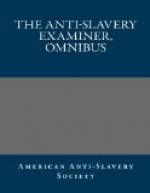The severity of this periodical pressure, in preparing for market other staples of the slave states besides sugar, may be inferred from the following. Mr. Hammond, of South Carolina, in his speech in Congress, Feb. 1. 1836, (See National Intelligencer) said, “In the heat of the crop, the loss of one or two days, would inevitably ruin it.”
6. Times of scarcity. Drought, long rain, frost, &c. are liable to cut off the corn crop, upon which the slaves are fed. If this happens when the staple which they raise is at a low price, it is for the interest of the master to put the slave on short rations, thus forcing him to suffer from hunger.
7. The raising of crops for exportation. In all those states where cotton and sugar are raised for exportation, it is, for the most part, more profitable to buy provisions for the slaves than to raise them. Where this is the case the slaveholders believe it to be for their interest to give their slaves less food, than their hunger craves, and they do generally give them insufficient sustenance.[27]
[Footnote 27: Hear the testimony of a slaveholder, on this subject, a member of Congress from Virginia, from 1817 to 1830, Hon. Alexander Smyth.
In the debate on the Missouri question in the U.S. Congress, 1819-20, the admission of Missouri to the Union, as a slave state, was urged, among other grounds, as a measure of humanity to the slaves of the south. Mr. Smyth, of Virginia said, “The plan of our opponents seems to be to confine the slave population to the southern states, to the countries where sugar, cotton, and tobacco are cultivated. But, sir, by confining the slaves to a part of the country where crops are raised for exportation, and the bread and meat are purchased, you doom them to scarcity and hunger. Is it not obvious that the way to render their situation more comfortable, is to allow them to be taken where there is not the same motive to force the slave to INCESSANT TOIL, that there is in the country where cotton, sugar, and tobacco, are raised for exportation. It is proposed to hem in the blacks where they are HARD WORKED and ILL FED, that they may be rendered unproductive and the race be prevented from increasing. . . . The proposed measure would be EXTREME CRUELTY to the blacks. . . . You would . . . doom them to SCARCITY and HARD LABOR.”—[Speech of Mr. Smyth, Jan. 28, 1820]—See National Intelligencer.
Those states where the crops are raised for exportation, and a large part of the provisions purchased, are, Louisiana, Mississippi, Alabama, Arkansas, Western Tennessee, Georgia, Florida, and, to a considerable extent, South Carolina. That this is the case in Louisiana, is shown by the following. “Corn, flour, and bread stuffs, generally are obtained from Kentucky, Ohio;” &c. See “Emigrants Guide through the Valley of the Mississippi,” Page 275. That it is the case with Alabama, appears from the testimony of W. Jefferson Jones, Esq. a lawyer of high standing in Mobile. In a series of articles published by him in the Mobile Morning Chronicle, he says; (See that paper for Aug. 26, 1837.)




